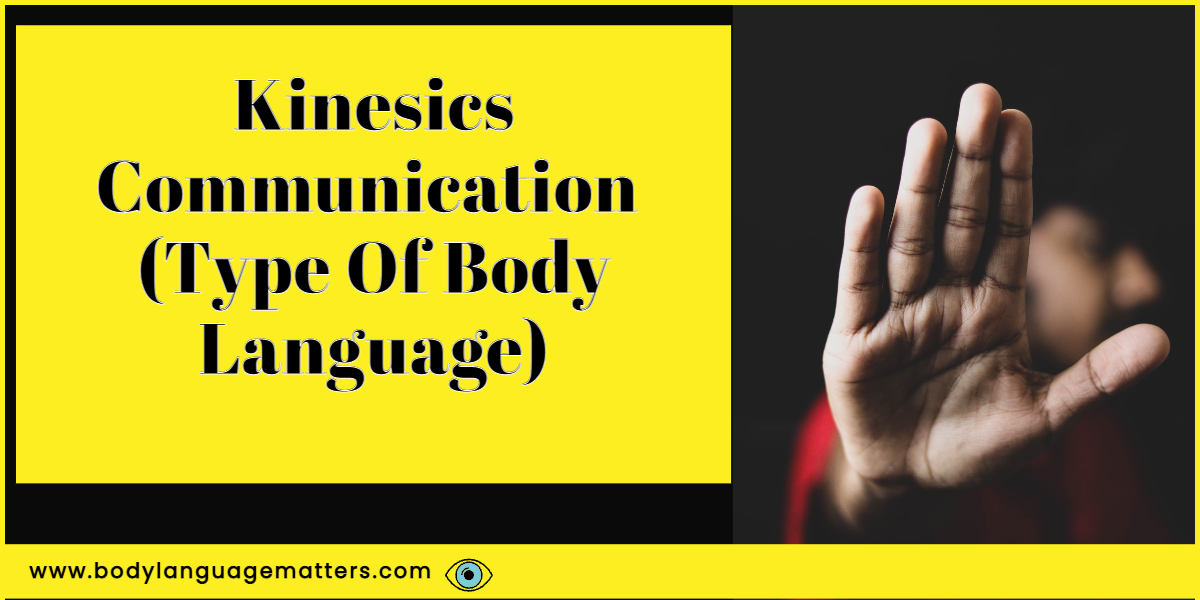Kinesics is the study of body language or body movement, especially facial expressions and gestures. It can be used to communicate nonverbal messages. Kinesic communication includes any part of the body that can be used to send nonverbal messages, including the face, eyes, arms, and legs. It is said that eye movements are so important that they should be studied on their own, which is called oculesics.
The four main areas of kinesics are facial expressions, gestures, posture, and eye movement. The term kinesics was coined by anthropologist Ray Birdwhistell, who applied it to individual body parts or the whole body.
Before we take a closer look at kinesics, it’s important to remember that many gestures can be interpreted in different ways depending on the context. For example, when someone puts their index finger to their lip, it could mean “be quiet” or it could mean “quiet” as in “quite I’m about to play a joke on someone.”We must always think about kinesics from a contextual point of view.
So what is context and why is it so important? We will take a look at that next.
- What is context, and why is it so important in Kinetic body language?
- It’s a form of nonverbal communication.
- It’s the study of human movement Kinesics.
- It can be used to improve communication Kinesics.
- It can be used to understand emotions Kinesics.
- Kinesics Are Not Universal.
- Frequently asked questions
- Final Thoughts.
What is context, and why is it so important in Kinetic body language?
Context is defined as the circumstances that form the setting for an event, statement, or idea. Context is important in kinesics because it helps us decipher what a person’s movements mean. Context can tell us if a person is being sincere or sarcastic and can also tell us whether a person means what they are saying or not.
Context is everything going on around you or the person you observe; it’s the people you’re around, where you are, and what is happening. This will give you some factual information you can use to think about kinesics and body language.
Next, we will take a look at the five ways kinesics is used in communication.
- It’s a form of nonverbal communication.
- It’s the study of human movement.
- It can be used to improve communication.
- It can be used to understand emotions.
It’s a form of nonverbal communication.
Kinesics is a form of nonverbal communication that involves body movements and gestures. It is a form of body language. Kinesics can be used to communicate emotions, thoughts, and attitudes through facial expressions, gestures, posture, and tone of voice.
The use of kinesics has been studied by many disciplines including psychology, sociology, anthropology, biology and linguistics. To learn more about nonverbal communcation we highly recommend you check out How To Read Body Language & Nonverbal Cues (The Correct Way)
It’s the study of human movement Kinesics.
Kinesics includes a number of different types of movements that can be used to communicate with others, such as hand gestures, facial expressions, and body movements.
It can be used to improve communication Kinesics.
Communication is the process of exchanging information and ideas in a way that becomes clear to the receiver. However, there are many factors which can make communication ineffective.
For example, if a person is not able to convey their message due to a lack of words or vocabulary, then it will be difficult for them to communicate effectively. Kinesics is another factor that can affect communication. It refers to non-verbal signals like gestures, facial expressions etc. We all use kinesic communication to signal to others how we feel, such as pointing to a watch or waving our hands to count down how much time we have left.
It can be used to understand emotions Kinesics.
Kinesics can be used to display emotions. For example, people who are sad will use kinesics to display their emotions, like a thumbs down or a happy person will display the opposite, a thumbs up. So, yes, kinesics can be used to display emotions.
Kinesics Are Not Universal.
Kinesic behavior is not universal; it varies from culture to culture. For example, a smile may be seen as a positive gesture in some cultures but a negative one in others depending on the hierarchy.
Frequently asked questions
What’s the Difference Between Kinesics and Body Language?
Body language is a nonverbal form of communication that can be used to understand the emotions and thoughts of others. It can also be used to understand one’s own emotions.
Kinesics is the study of body movements, gestures, and expressions as a means of communication. It includes facial expressions, eye contact, posture, gesture, and tone of voice.
Body language is very important in everyday life because it can tell us how people are feeling about themselves or about other people. Body language also helps us to understand what people are saying without them speaking out loud or writing it down on paper.
What are the 5 types of Kinesics?
- Emblems
- Illustrators
- Affective displays
- Regulators
- Adaptors
What are the differences between Kinesics and proxemics?
Kinesics is the study of body language, facial expression, and gesture. People use kinesics to communicate non-verbally. Proxemics is the study of how people use space to communicate. There are four types of proxemics: intimate, personal, social, and public. Intimate space is reserved for family and close friends. Personal space is for people you know well, such as co-workers. Social space is for acquaintances, such as people you might meet at a party. Public space is for strangers.
How do we use Kinesics?
We can use kinesics to communicate with others without verbal communication in most social situations. For example, we may frown when we don’t like the topic of conversation, or we may nod to show that we agree with what someone has said. Our body movements can convey meaning even when we are not consciously aware of it.
Final Thoughts.
When it comes to understanding kinesics and communication, there are plenty of ways to think about it, for example, emblems like holding up your hand to display a number or the middle finger to show your annoyance. It’s just about getting the balance right. We hope you have enjoyed reading and learned something from this post until next time stays safe.

